By
Tom Shaw
Photography by E. John Thawley III and Tom Shaw
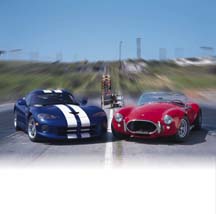 Remember how it was in the Sixties? To ascend to the
pinnacle of street performance, you had to work your way up. First you
chewed up the bottom feeders, then moved on to intermediate predators
before earning a shot at the big fish. Remember how it was in the Sixties? To ascend to the
pinnacle of street performance, you had to work your way up. First you
chewed up the bottom feeders, then moved on to intermediate predators
before earning a shot at the big fish.
At least at this
magazine, the tradition continues today. In our December/January 1997
issue's "Cubes vs. Tech" cover story, Dodge's electrifying new Viper GTS
vaporized a field of the fastest vintage and current musclecars. In
distant second place, almost a full second off the pace, was another
Mopar, an exceptionally strong '70 440+6 'Cuda. So, after a first round
knockout of thirty years worth of Detroit's hottest iron, the Viper has
earned its title shot at the king.
The legendary 427
Cobra has reigned supreme over Musclecar Review's Fifty Fastest
Musclecars list since it first hit the streets thirteen years ago
(November 1984). At the top of that list, compiled from road tests from
the musclecar era, is Car & Driver's November 1965 road test of
a 1966 427 Shelby Cobra, which reported a 12.2 @ 118 mph ET. For over
thirty years those numbers have stood like the rock of Gibraltar. Nothing
could touch the 427 Cobra-bullets bounce off its chest, it's every car
guy's fantasy date, it single-handedly justifies the invention of gasoline
and is probably what's luring aliens to visit our humble little
planet.
The 450-hp V10 Viper
GTS is borne of surprisingly similar DNA, benefiting from modern
refinement, a couple of extra cylinders and even more displacement,
computerized engine management and tires that racers could only dream of
in 1965. Under that long, sleek hood beats 10 cylinders of superhero
power. The Viper GTS' intimidating appearance dares anyone to tangle,
while the V10's tornado-like torque provides the surely-I'm-dreaming
acceleration. We ran an eyeball-popping 12.07 @ 115.20 with a Viper GTS
last summer.
But that was then.
Comparing different tests from different tracks on different days may make
for amusing bench racing, but that's about all. If ever a car stood a
chance of knocking the 427 Cobra off its pedestal, it's the Viper
GTS.
So with all-time
bragging rights and the two fastest American production cars ever built
both on the line, let the shootout begin.
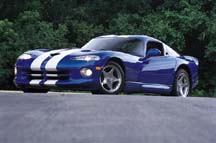 The Viper GTS was actually tangling with two Cobras; Lynn
Parks' 427, live, in person and appearing in the other lane, and Car
& Driver's decades-old road test. Likewise, Lynn's Cobra was
battling both the Viper GTS and the Car & Driver test
too. The Viper GTS was actually tangling with two Cobras; Lynn
Parks' 427, live, in person and appearing in the other lane, and Car
& Driver's decades-old road test. Likewise, Lynn's Cobra was
battling both the Viper GTS and the Car & Driver test
too.
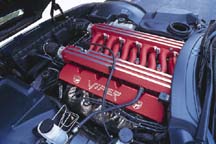 Spotlessly gleaming in California's early morning sunlight
just an hour South of the Los Angeles airport where it was created, the
Cobra bellowed to life on the first spin of the starter, its signature
sidepipe throb escaping almost unchanged through minimal muffler baffling.
Warming the fluids, Lynn eases down the track and back, every eye
following him and his car. On his second warm-up pass, about halfway down
track, he finally punches it. The radical red bullet squats slightly and
rockets away in a frenzy of sound and speed. It doesn't miss a beat. This
Cobra appears to run as good as it looks, and it looks
fantastic. Spotlessly gleaming in California's early morning sunlight
just an hour South of the Los Angeles airport where it was created, the
Cobra bellowed to life on the first spin of the starter, its signature
sidepipe throb escaping almost unchanged through minimal muffler baffling.
Warming the fluids, Lynn eases down the track and back, every eye
following him and his car. On his second warm-up pass, about halfway down
track, he finally punches it. The radical red bullet squats slightly and
rockets away in a frenzy of sound and speed. It doesn't miss a beat. This
Cobra appears to run as good as it looks, and it looks
fantastic.
The Viper GTS is a
press fleet vehicle, built in February 1996, updated to 1997 specs and
doubtlessly flogged by every janitor, neighbor and brother-in-law at every
magazine assignment it's ever been on. And in 13 months on the job in
Southern California, it's been on quite a few. But the 15,000 hard miles
showing on the odometer doesn't mean that the Viper is broken up, just
broken in.
Long-time readers may
have noticed that recent shootouts have scrapped the best-two-out-of-three
format in favor of a run-till-you're-happy approach. This eliminates the
entire shootout hinging on one bad run or missed shift.
The air was clean,
cool and clear. A mellow breeze blew down the track. Just before noon, the
two warriors staged. Lynn, wearing his star-spangled full-face helmet, and
your writer, gripping the shifter, awaited the green. Both drivers
overpowered the big tires, then recovered from tirespin that would have
made a teenager proud, but racked up miserable 2.3-second 60-foot times.
Moving downrange, a missed shift in the Viper netted a 13.49 @ 115.28 mph
ET, while the Cobra turned in a 12.71 @ 116.23 pass.
Returning to the same
lanes, the Viper got off the line with a 2.18 60-foot clocking, a tenth
quicker than Lynn's 2.27. By mid-track the Cobra had pulled to dead even
and burst through the traps with a 12.56 @ 117.32, one micro-whisker ahead
of the Viper's 12.58 @ 115.67.
The Cobra and Viper
appeared to be very closely matched. From the driver's perspective, the
two cars ran neck-and-neck. Neither seemed to have any meaningful
horsepower power advantage, so it looked like it would come down to a
driver's battle. With a couple of shakedown runs under our belts, we were
looking forward to rolling up our sleeves and really duking it
out.
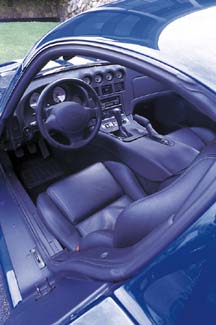 Instead, track personnel intervened to announce that because
the Cobra had no roll bar, it was considered a convertible by NHRA
regulations and couldn't run quicker than a 14-second ET without violating
the hallowed insurance policy. After exhausting our entire portfolio of
arm-twisting and manipulation techniques, we were resigned to run 1/8-mile
passes and compare them to the Viper's timeslips at the same place on the
track. That, and the two full passes that Lynn had already made would have
to represent the Cobra today. Instead, track personnel intervened to announce that because
the Cobra had no roll bar, it was considered a convertible by NHRA
regulations and couldn't run quicker than a 14-second ET without violating
the hallowed insurance policy. After exhausting our entire portfolio of
arm-twisting and manipulation techniques, we were resigned to run 1/8-mile
passes and compare them to the Viper's timeslips at the same place on the
track. That, and the two full passes that Lynn had already made would have
to represent the Cobra today.
Taking this all in
stride, Lynn saddled up and spurred the Cobra to two more 1/8-mile passes,
8.20 @ 92.46-his quickest yet-and a 8.68 @ 88.61, a couple tenths off the
mark of his first two runs (8.435 @ 89.60 first run and 8.34 @ 91.16 on
the second run, both at the 1/8-mile mark).
With that, it was
time to concentrate on the Viper. As with our previous Viper experience,
and that of our sister magazine, Mopar Muscle, running 12.50s with
a Viper GTS is as easy as falling off a rock. Dipping into the 12.30s
takes a bit more concentration, and to get down to the .20s and teens,
takes iron discipline to back off the throttle at launch. Letting the
Viper's surplus horsepower spin the tires will give you a miserable
2.20-2.30 60-foot time, meaning that by the time your foot hits the floor
in first gear, your chances for a good run have already gone up in smoke.
The first 60 feet are the make-or-break point for the Viper (and Cobra for
that matter). Because the rest of the run is just steering straight and
shifting gears, you can watch your ET rise or fall with your 60-foot
times.
On run 15 the Viper
set Carlsbad on fire with a 12.15 @ 119.06 mph ET, its best time of the
day. Trying to better that mark produced a 112.17 @ 120.50 and a 12.18
@119.30, but the 12.15 would stand as the Viper's quickest ET of the
day.
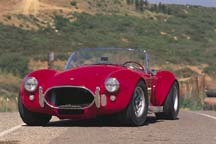 That covered the Cobra's full runs by over four-tenths of a
second. But how about comparing Lynn's 1/8-mile passes? Here's a
comparison of the Viper and Cobra's best three 1/8 mile
clockings. That covered the Cobra's full runs by over four-tenths of a
second. But how about comparing Lynn's 1/8-mile passes? Here's a
comparison of the Viper and Cobra's best three 1/8 mile
clockings.
|
|
| |
Viper |
Cobra |
|
7.992 @
92.95 |
8.200 @
92.46 |
|
8.044 @
93.18 |
8.340 @
91.16 |
|
8.053 @
93.47 |
8.435 @
89.60 |
|
Average |
8.029 @
93.20 |
8.325@91.073 |
The Cobra's average
1/8 mile ETs are consistent with 12.50 ETs. In fact, that 1/8-mile average
is nearly identical to the Cobra's 1/8-mile times on its second full
pass.
So after crunching
the numbers, the Viper bested the mighty Cobra in every category; 1/8
mile, 1/4 mile, and mph.
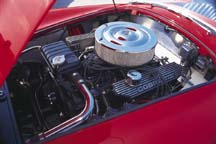 Admittedly we had more time to work with the Viper, and in
all fairness, taking into account how close the two were during those
first two runs, we'd have to say that on any given day this contest would
come down to the driver, lane, launch and any of the many variables that
can add or subtract a tenth or two. But on this day, those variables went
in favor of the Viper. Admittedly we had more time to work with the Viper, and in
all fairness, taking into account how close the two were during those
first two runs, we'd have to say that on any given day this contest would
come down to the driver, lane, launch and any of the many variables that
can add or subtract a tenth or two. But on this day, those variables went
in favor of the Viper.
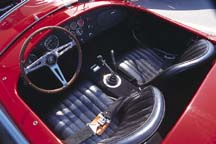 While the Viper was knocking off Cobras, it also knocked off
Car & Drive's 12.20 @ 118, again, besting it in both ET and
mph. And that makes it ... the new King of the "Fifty Fastest
Musclecars." While the Viper was knocking off Cobras, it also knocked off
Car & Drive's 12.20 @ 118, again, besting it in both ET and
mph. And that makes it ... the new King of the "Fifty Fastest
Musclecars."
And let's be
honorable here and give credit where credit is due. Nobody gave the Viper
GTS a free pass. It earned its victory in the heat of battle. It slayed
the dragon, OK, the serpent, and returned to its kingdom a
champion.
So, at the final
bell, the end of a 31-year reign is at hand, like it or not. It was a fair
fight and we must now wistfully acknowledge the legendary Shelby 427
Cobra's passing from the exalted summit of the performance car world to a
spot just one rung lower on the pecking order. And though it's just one
little spot in rank, symbolically, it's a fall equivalent to the plunge of
the Mexican cliff divers. To those who get a lump in their throat at the
notion of the Cobra falling from Number One to Number Two, we offer these
condolences: 1) At least it wasn't the arch-rival Corvette that dethroned
it; 2) The Viper GTS is probably what the Cobra would have evolved into
had it lived on; 3) The King is gone, but thankfully, the King is not
dead.
The Cobra, its
world-beating record and the overkill throttle thrill that makes your
eyeballs roll back in your head has not disappeared. The Cobra was, is
still alive and well, and will always be a mushroom cloud on the
automotive landscape.
So, what does that
make the Viper? |